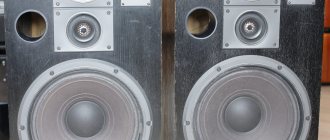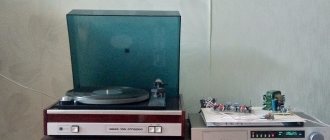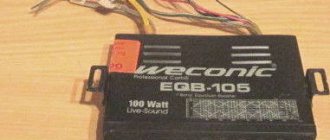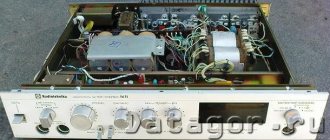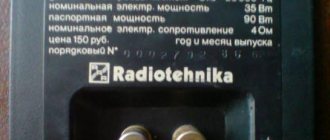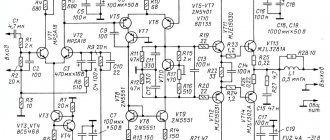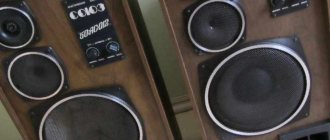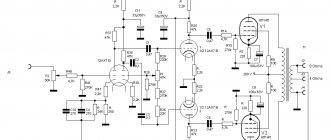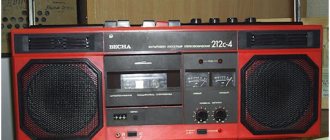Radiotehnika – history of the Riga Radio Plant
VEF Radiotehnika RRR is a Latvian manufacturer of radio equipment and speaker systems. Founded in 1926, in Riga, Latvia. Founder: Abram Leibovitz.
RRR stands for Rīgas Radio Rūpnīca Riga Radio Factory in Latvian .
At the beginning of the enterprise's existence, the plant was engaged in the production of receivers and radio receiving equipment. In the 30s, Leibovitz invited Alexander Apsitis to work, but he did not work for long, as they did not agree on some work issues. In 1934, Apsitis registered his company - A. Apsitis & F. Zhukovskis for the production of receivers and radio components. Leibovitz attracted customers through the appearance of his products and advertising. If there was an opportunity to make a profit at the expense of quality loss, it was not missed. Apsitis emphasized quality and his models were assembled perfectly. Ultimately, it was Apsitis who made the maximum contribution to the development of the enterprise, which would later become known as Radiotehnika .
After joining the USSR, the sales market for Riga radio equipment expanded, but production was interrupted by the war. In 1940, the plant was nationalized, and management was entrusted to Leibowitz's sons. The company was merged with the Nikolajs Klemptners enterprise, under the general name Radiopionieris . Apsitis's enterprise was merged with several small private companies called Radiotehnika . During the war, the Germans merged both companies, making them a branch of Telefunken Geratewerk Riga , where production of products for the German war effort began
After the liberation of Riga in 1944, the plant had equipment, measuring equipment and a supply of materials at its disposal. In the post-war period, it became the largest manufacturer of audio equipment in the USSR, accounting for 35% of output. RRR was one of the defense “nine” of the USSR and actively exported its products to the markets of Germany, Finland, the USA, and Australia (where they sold more than 5,000 speaker systems ).
In 1945, the Riga T-689 :
In 1948, the USSR produced the first portable tube radio receiver, Pioneer :
In 1949, production of the Riga B-912 :
In the early 50s, the Riga-10 . It had 10 lamps and weighed 24 kg, consumed 85 W from the network and received broadcasts in the HF, SV and LW bands. And to ensure good sound, a wideband speaker was used.
In 1951, the plant was named after the electrical engineer and inventor A.S. Popov, but plant director Alexander Apsitis is demoted due to “failure to fulfill the plan”, and then completely arrested. Four months later he was released from prison, but did not return to the plant.
According to Inars Klavins, who worked at Radiotekhnika for 33 years, the plant’s equipment was bought from Germany, France, Britain and other Western countries. The production of radio equipment at the plant grew rapidly, by 1954 it reached 100,000 pieces, and by 1962 - 200,000 pieces. Under the leadership of Pavlovsky, who was appointed in 1958, the development of small-sized receivers “Gauja” and “Selga” began.
The first transistor receiver "Gauja":
In the early 60s, the plant produced automobile receivers, such as APV-60-2 , which were installed on Chaika and ZIL-111 :
In 1963, the first major development of the combined RRR and VEF was the Rigonda-stereo radio, which consists of a tube radio with a stereo amplifier, a player and a pair of speakers. The speaker system is equipped with a pair of front 4GD-28 and a pair of side 1GD-18 . In 1967, Radiola was awarded a gold medal at the international Leipzig fair.
Radio “Rigonda-stereo” with a pair of speakers:
In 1964, “RRR” launched the first closed-type acoustic systems in the USSR, Symphony 1GD-3 ), MF ( 3GD-1 ) and LF ( 6GD-2 loudspeakers were specially developed .
Simfonija 2 is a modernized version of the first:
For the Victoria-001 the AC-40-8 woofer was developed , the first in its class and intended only for closed-type speakers . In the same year, the plant was headed by Oleg Konstantinovich Lenev, who turned it into a production facility with 16,000 workers. A year later, the plant was subordinated to the All-Union Ministry of Communications Industry, which provided it with access to foreign exchange resources for the purchase of equipment.
Victoria-001-stereo:
In 1970, a production association was formed, which included the Riga Radio Plant named after. A.S. Popov, KB "Orbita", Riga Electromechanical Plant and Kandava Radio Plant. After 3 years, the plant’s production moved to new spacious buildings with conveyor and production lines and imported equipment. A special acoustic laboratory building was built with large-volume anechoic and reverberation chambers. In 1984, construction of microelectronics production began.
the 35AC-1 and S-90 acoustic systems , the latter becoming the most widely produced in the USSR and recognizable even today.
Radiotehnika S-90:
35AC-1 Radiotehnika:
The production association grew until 1990: 1.5 million units of radio equipment were produced annually in new areas, including 1.1 million speaker systems ( 12 models ). Radiotekhnika was a leading manufacturer of high- and first-class equipment in the USSR. In total, from 1945 to 1990, production produced 41.5 million products with the “RRR” logo. Not a single plant in the USSR could compete with Radiotekhnika. The plant had its own pioneer camp and recreation centers in Crimea.
Photo of the plant in 1982:
To expand exports, several joint ventures were founded, including Hamrig International with the Germans to trade speaker systems in Europe under the Norsk Audio . For this purpose, isolated areas were organized in which assembly was ensured by special marking of components, separating them from mass production. German partners provided Radiotekhnika with the Autocad program for design and the Calsod program for electronic modeling of power frequency division filters in acoustic systems.
Baltic 90:
In 1991, after Latvia left the Soviet Union, Radiotekhnika lost its sources of raw materials and sales market. There were proposals to create cooperatives on the basis of the association, which received premises and equipment for rent on preferential terms, taking upon themselves the responsibility to carry out the plant’s tasks. However, most of them went bankrupt.
Imported products poured into post-Soviet markets, but Riga speaker systems remained competitive. At first it produced acoustic systems, and in 1996 the joint stock company “Radiotehnika RRR” , which after purchasing the equipment from the VEF plant became known as “VEF Radiotehnika RRR” . In the same year, it separated from the state joint-stock company “Riga Radio Plant”.
Baltlines Audio Sonicsound S-300F-1:
The RRR plant was declared insolvent in 1997 and liquidated in 2001. In 2015, VEF Radiotehnika RRR JSC announced the sale of an abandoned factory management building in Riga and in 2018 it was demolished, now a store is located in its place.
Factory administration building before demolition:
In 2011, World Audio Distribution launched its own production of acoustic systems in Riga, from cabinet manufacturing to finished products under the Arslab . The production is headed by Viktor Lagarpov, who was the chief engineer at Radiotekhnika. In addition to assembling the acoustics themselves, the plant produces speaker cabinets for other manufacturers from Germany, France, Italy, etc. In 2014, WAD acquired a controlling stake in Penaudio .
Based on materials – wikipedia.org, pravda-tv.ru Photo – rw6ase.narod.ru, radiopagajiba.lv
KV.by
Today we will tell you about the history of the Riga VEF plant - in the past a giant of radio electronics of Union significance, but today, unfortunately, undeservedly forgotten.
Start
The WEF appeared even before the arrival of Soviet power in the Baltics. The plant managed to grow from small workshops to one of the largest factories in the country. It was a difficult path - during the times of bourgeois Latvia, receivers were massively imported from abroad and the EEF simply could not have survived if one of its influential owners, the intelligent man Alexander Tipainis, had not taken a daring step: he initiated amendments to the legislation that established a high import duty on receivers. And things went smoothly. So much so that the plant soon began exporting products abroad. Up to 8,000 receivers went there annually (remember that at that time it was slightly less prestigious to have a tube radio than a car).
VEF tube receivers received the “Grand Prix” at international exhibitions in 1935 in Brussels and 1937 in Paris. In those same years, the first motorcycles were assembled at the EEF, whose design anticipated the famous Harleys and even cars. And from the 60s to the 90s of the 20th century, the plant was one of the leaders of the Soviet radio-electronic industry.
A story from a former WEF employee, Boris Troshin:
The sixties of the last century in Latvia were marked by a real technological breakthrough. The first experience of the Soviet leader Nikita Khrushchev in weakening total control over the creative initiative of the working masses was marked by an unprecedented increase in amateur design solutions and rationalization proposals.
The folk art of originalists was especially evident at the leading enterprise in Riga, the VEF plant. The abbreviation VEF is translated from Latvian as “State Electromechanical Factory”. And this is a completely justified generalization. What have they not produced at the enterprises of the VEF group! And telephones, and tube receivers, and motorcycles, and all-terrain vehicles. Even airplanes were produced there.
But VEF gained worldwide fame for introducing into production small-sized transistor receivers of the “Spidola” type. “Spidola” in Latvian folklore “Lachplesis” was the name of a fantastic creature - a witch.
At that time, the receiver’s abilities seemed truly magical. It was so sensitive that it picked up stations all over the globe. The receiver turned out to be quite advanced for those years, technologically advanced and unpretentious. As a result, “Spidola” gained wide popularity and was sold in almost all countries of the world.
Here, at the VEF plant, real miniature cameras of that time were manufactured, used even for surveillance and espionage purposes, with high resolution, unpretentious in operation and very reliable (according to some sources, they were produced until the beginning of the new century).
While visiting the EEF, Nikita Khrushchev drew the attention of the plant management to the fact that in post-war times, technical innovations were more necessary and in demand by the country than ever before. And by order of command he demanded to encourage young talents and create favorable creative conditions for them.
This is how the inventors Waldemar Busch and Jan Mengelis, outstanding for the sixties, appeared, later awarded state prizes. Jan Mengelis invented an automatic line for the production of relay springs for telephone exchanges, and Waldemar Busch created a small-sized multi-operational machine that replaced a whole cascade of units with similar functions. Later, the Speedola technologies were transferred to the Minsk Gorizont plant, which mastered the production of Ocean receivers, which were also quite popular in the USSR in the pre-perestroika years.
WEF was not alone. Others worked in the system (Riga Electromechanical), radio and others.
The past of Riga is interesting. It once produced vinegar essence, lead and zinc paints. But since 1940, it was reoriented by Soviet specialists to produce electrical products. However, war broke out.
With the liberation of Riga, the Soviet government did not immediately decide to revive the territory of the plant, but when this happened, the Council of People's Commissars decided to start producing players that compete with foreign analogues. Dozens of specialists from Russia were sent to Riga. REMZ nominated its talented innovators - Yurtsev, Blomberg, Antonov, who were the creators and developers of unique automatic lines and robotic systems.
The most talented specialists who came from the military industry worked at REMZ - E. Sklyarsky. E. Borovikov. In Panchenko. P. Antonov. V. Yatsenko - order bearers who introduced the latest achievements of scientific thought into civil production. The shift grew as well. The post-war years were famous for homelessness, which the Soviet government successfully fought against. Thanks to this struggle, those who, under a different government, could have drunk themselves in the gates or gone to prison, came to the factories - former street children and hooligans who plied their trade in the gangster district of Riga at that time - “Strelkovoy Park”. This was a famous “spot” where the local “punks” gathered. One of its leaders, a strong guy nicknamed “Korob,” got a chance to change his life by getting a job at REMZ. And he used this chance. I knew this charismatic and intelligent guy. Such people become leaders everywhere - both at Komsomol construction sites and among bandits, depending on where they end up first. “Korob” managed to emerge from the leadership of the “punks” without losing his freedom and began a new life. At first he worked as a mechanic, then, thanks to his diligence and leadership qualities, he was recommended as a foreman, entered a technical school, became a foreman of the galvanic department, and over time, a respected person in the city - the director of "REMZ" Semyon Iosifovich Kodner. This was the case with many young guys in those years. Soviet power helped them find a new, decent life and achieve serious success in it.
Perhaps the most famous person is the worker, inventor, Hero of Socialist Labor of the USSR Voldemar Petrovich Bush, whom Boris Troshin mentioned above. At one time they wrote a lot about him in Latvian newspapers and in the central press of the USSR. Here's what he told the correspondent of the magazine "Technology - Youth" back in the seventies:
“I was a metalworker by trade. I often repaired one stamp, which for some reason often broke. It seemed to me that this stamp was not designed correctly and I suggested making it differently, and this was my first invention. My stamps not only stamp, but also bend, carve, and process the product. These are small automatic production lines. Now I have at my disposal an estimate, equipment, and staff, with engineers subordinate to me. I came across a gold mine - I’m developing it until it runs out. And mechanics, and engineers, and even doctors of sciences, if they are simple, will not invent machines. This is a business for difficult people.”
Bush and the workers of his site were given “carte blanche” and a salary, with the direct participation of N. Khrushchev personally, who visited the plant and met the talented self-taught man. Even today, you can find many articles on the Internet about Voldemar Bush and his inventions - in Soviet-era popular science magazines and scans of newspapers. His patents are also publicly available.
History of success
Of course, the transistor receivers “Speedol” brought the greatest popularity to the plant. This was such a scarce product that it could easily be exchanged for an official signature in the then Moscow ministries. Factory workers actively took advantage of this, thus ordering scarce materials (the plant was even allowed to import). Before Spidol, the company mass-produced tube receivers that sold poorly. One day, stores from all over the USSR even began to return whole trains of them back to the factory, and this equipment filled all warehouses and utility rooms. The expansion of the production of Spidol, and later the VEF-Transistor that replaced them, allowed the plant to become the leading manufacturer in the country.
The radio-electronic industry in the sixties of the last century in the USSR was rather backward. The receivers were huge and heavy. Here is what former industry specialist Mikhail Lobanov says about this:
“Receivers were produced everywhere, including in military factories. But even at that time they had a completely non-commercial appearance. For example, in Sarapul they produced a large tube receiver in an aluminum case with welded parts! circuit boards. Of course, you can’t take such a receiver far and you can’t listen to it on the beach. It had great limitations in the frequency range, was difficult to configure and had low sound quality.
VEF products had, in comparison with such technology, a lot of undeniable advantages: the HF range, on which one could hear Western radio stations, modern music (we rarely heard it then), excellent sound quality, confident tuning, low weight and size. Speedolas were hard to come by. Only people with connections could buy them.
The shortage of radio equipment resulted in the fact that at one time even craftsmen assembled portable receivers in radio workshops and at home. They sounded terrible because they had no interference compensation channels, but they were small.
Only years later, when VEF supplied millions of receivers and transferred its technologies to other enterprises, did radio become available to everyone.”
The plant was actively being built - branches appeared in different cities, a huge multi-story office, a palace of culture, various social facilities, and infrastructure. The company had its own clinic and catering plant.
In 1991, at the peak of its development, the enterprise produced hundreds of products, including “combines”, quite modern for those times (a hybrid of a tape recorder and a receiver), both in portable and stationary versions. VEF's successor, Radiotekhnika, offered consumers in the early nineties even one of the first CD players in the post-Soviet space.
Few people remember and know that VEF even made portable computers - microprocessor complexes UMK - small computers that fit into a "diplomat".
Oblivion
The authorities of the new Latvia were unable to support the company during its difficult days.
Here's what he told the BBC Russian Service about it
»
ex-head of the electronics department of the Ministry of Industry and Energy of Latvia Inars Klavins:
The most significant part of VEF - VEF-KT - at one time produced switching equipment, it was in this area that the most workers were employed under the USSR - 14 thousand out of 20 thousand. And in the early 90s there were 400 people left. At one point, having completed a state order, the joint-stock company did not receive the payment due from the budget - more than three million dollars
,
tax debts began to accumulate, which, together with penalty interest, amounted to about $15 million
.
It got to the point that, due to debts to the social budget, the company could not even fire employees. A thousand workers were able to leave the plant in a civilized manner only a few years later, when the enterprise received money from the Privatization Agency. As a result, part of VEF-KT became the property of PK Investments, a subsidiary of the Pro Kapital concern, owned by Italian entrepreneur Ernesto Preatoni. On the site of a former factory, he opened one of the largest retail stores in Riga.
Another part of the plant - VEF-REC - at the time of privatization produced agricultural products, mechanization equipment, equipment for sawmills and even hydraulic turbines for small hydroelectric power plants. 130 people managed to work without water or heating, under leaking roofs. After going through an insolvency process, the company became the property of the American company Harvey International Ltd. By the way, under the name VEF-REC it still exists, is located on the territory of the old VEF and is engaged in production.
The new owners believed that the market would regulate everything, that, in the end, they would be helped by their Western partners, who were so passionate about the liberation of Latvia. But the political businessmen were wrong.
You can't bring back the past
The most interesting thing is that the new Latvian authorities still regret the loss of the country's largest enterprise. Of course, now it would hardly be able to compete with Chinese manufacturers. But this is not necessary - there are already enough niches in which Riga residents could successfully work.
You don't have to look far for examples. In the same difficult conditions, Riga Radiotehnika (VEF Radiotehnika RRR), which I have already mentioned, continues to develop. The company produces acoustic systems, and is still considered their leading manufacturer in Eastern Europe! Over time, the production of printed circuit boards also became part of Radiotekhnika, the same place where the famous innovator, mechanic Bush, once worked with his site. But this is a completely different enterprise, not nearly comparable in scale to VEF.
For anyone who wants to see “VEF” today, Riga residents will be happy to show the forgotten buildings located in the Northern microdistrict of Riga, where unique production was once in full swing, of which the city, the republic, and the country were rightfully proud.
The author thanks Mikhail Lobanov and Boris Troshin for their help.
Eduard Troshin
